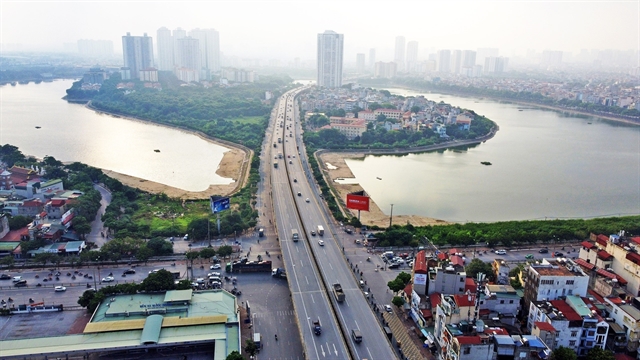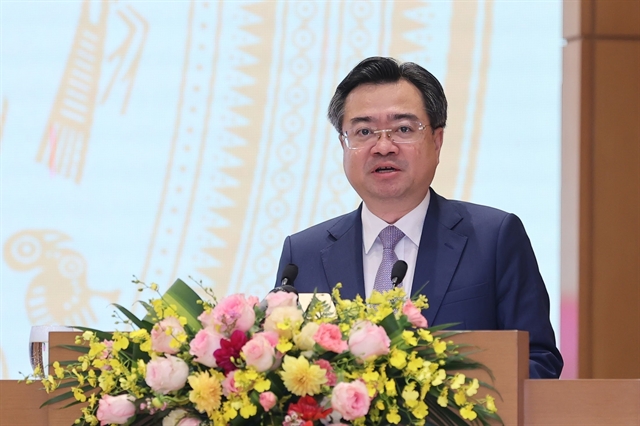 Politics & Law
Politics & Law


|
| Hà Nội's Ring Road No.3 passing through the Linh Đàm peninsula in Hà Nội. — VNA/VNS Photo Huy Hùng |
Minister of Construction Nguyễn Thanh Nghị spoke to Vietnam News Agency on the growth of the sector in 2022 and its priorities for 2023 and onwards, especially with regard to urban planning and real estate.
2022 is a year of many difficulties, but the construction industry has achieved good growth, all things considered. How do you evaluate the results of the construction industry achieved in the past year?
2022 is a year of recovery, a foundation year in the realisation of the goals of the Resolution of the 13th Party National Congress and the five-year socio-economic development plan 2021-26. But Việt Nam’s economy has had a lot of complex, unprecedented problems to deal with, with intertwining advantages and headwinds, while climate change and natural hazards continue to grow in intensity and unpredictability, and as the global economic and political situation are highly volatile.
In that context, with the attention and leadership of the Party, the National Assembly, the Government, the Prime Minister, the close coordination of central and local ministries, along with the efforts from workers, officials, employees and the business community in the whole industry, in 2022, the construction industry has overcome difficulties and challenges, met and even exceeded all the main goals and targets.
The industry recorded a growth rate of 8.17 per cent, significantly higher than the objective of 5.6 per cent. The urbanisation rate countrywide has hit 41.7 per cent, 1.2 per cent higher than 2021. The proportion of the urban population having access to clean water through a centralised water supply system reached 94.2 per cent, up 2.2 per cent compared to the year before.
The average floor space for each person in the country reached 25.5sq.m., up 0.5sq.m compared to 2021.
The effectiveness and efficiency of State management in the fields assigned by the Government are enhanced. At the same time, legal institutions in construction continued to be improved with higher quality, contributing to a more favourable, open, and strongly decentralised environment for the local governments.
Planning, architecture and urban development management activities continue to receive more attention and be implemented effectively. Construction investment management also witnessed positive changes, with the quality of the works basically under supervision. Inspection, examination, verification, design appraisal, acceptance testing and capacity management of construction entities is strictly carried out, contributing to the prevention of loss and waste.
While the construction material market has seen serious fluctuations, especially a spike in costs in the early half of 2022, thanks to many efforts from the Ministry of Construction and localities, the market has stabilised from the third quarter of 2022.
The real estate market logged growth in the first months of 2022, but slowed down in the second half of the year due to many difficulties, especially the shortage of supply, lack of social housing, housing for low- and middle-income people, difficulties in mobilising and accessing capital sources, while corporate bonds in real estate began to reveal serious shortcomings and risks.
Construction authorities and the Government are proposing many sets of measures to develop a healthy, stable real estate market in 2023.

|
| Minister of Construction Nguyễn Thanh Nghị. — VNA/VNS Photo Dương Giang |
On January 24, 2022, the Politburo’s Resolution No.06/NQ-TW on the planning, building, management and sustainable development of urban areas in Việt Nam towards 2030, with a vision to 2045, was released. This is the first time the Politburo has had a thematic resolution on urban management and development. How has the Ministry of Construction participated in the making of the resolution and how does it plan to implement this?
We welcome the resolution, it affirms the role of urban development in the development of the country, and it also lays out strategic orientations – accompanied by specific tasks – that need to be done from now until 2030.
The construction ministry has then worked with other ministries, agencies, and localities to build the Government’s Resolution No.148/NQ-CP – which was issued on November 11, 2022 – on the implementation of the Politburo’s resolution.
The Government has set out its vision, specific goals and 33 specific tasks, along with the focal agency and coordinating agencies, the time of completion and deliverables so that the Government, ministries, and local authorities could implement the overall and specific objective of the Politburo’s resolution.
In order for Politburo’s Resolution No.06-NQ/TW to be widely disseminated to cities’ authorities throughout the country, the Ministry of Construction has coordinated with the Central Economic Commission and the Party Central Commission for Education and Information to organise conferences on the resolution – the Việt Nam Urban Sustainable Development Forum, along with three symposiums, and the National Urban Conference in 2022.
The world economy is forecast to have many unpredictable developments, affecting the country's economy, including activities of construction enterprises and the real estate market. Could you please tell me, what orientations and solutions does the Ministry of Construction have for 2023 and the following years?
In 2023 and the coming years, the construction industry will continue to focus on three key breakthroughs identified for the 2021-2026 term of the industry, which are perfecting the legal institution on construction to strengthen state management, at the same time creating a favourable and open environment for people and businesses, further decentralisation (to local governments) to remove bottlenecks that hinder the development of the industry and the operation of enterprises.
In addition, the Ministry of Construction will focus on urban development planning and management, improve the quality of planning to match the mindset, vision, and forecasting while ensuring feasibility. We will exercise strict control in the stages of planning appraisal and adjustment, as well as strengthen local inspection and guidance activities, and rectify local authorities’ capacities and conduct in planning issues.
At the same time, legal regulations and management tools will continue to be perfected to strictly control the process of synchronous urban development – one that goes in tandem with industrialisation, modernisation, rural development, enhancing the competitiveness of urban areas, effectively using resources, especially resources from land, from urban space development. — VNS




